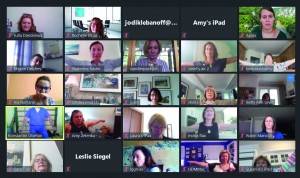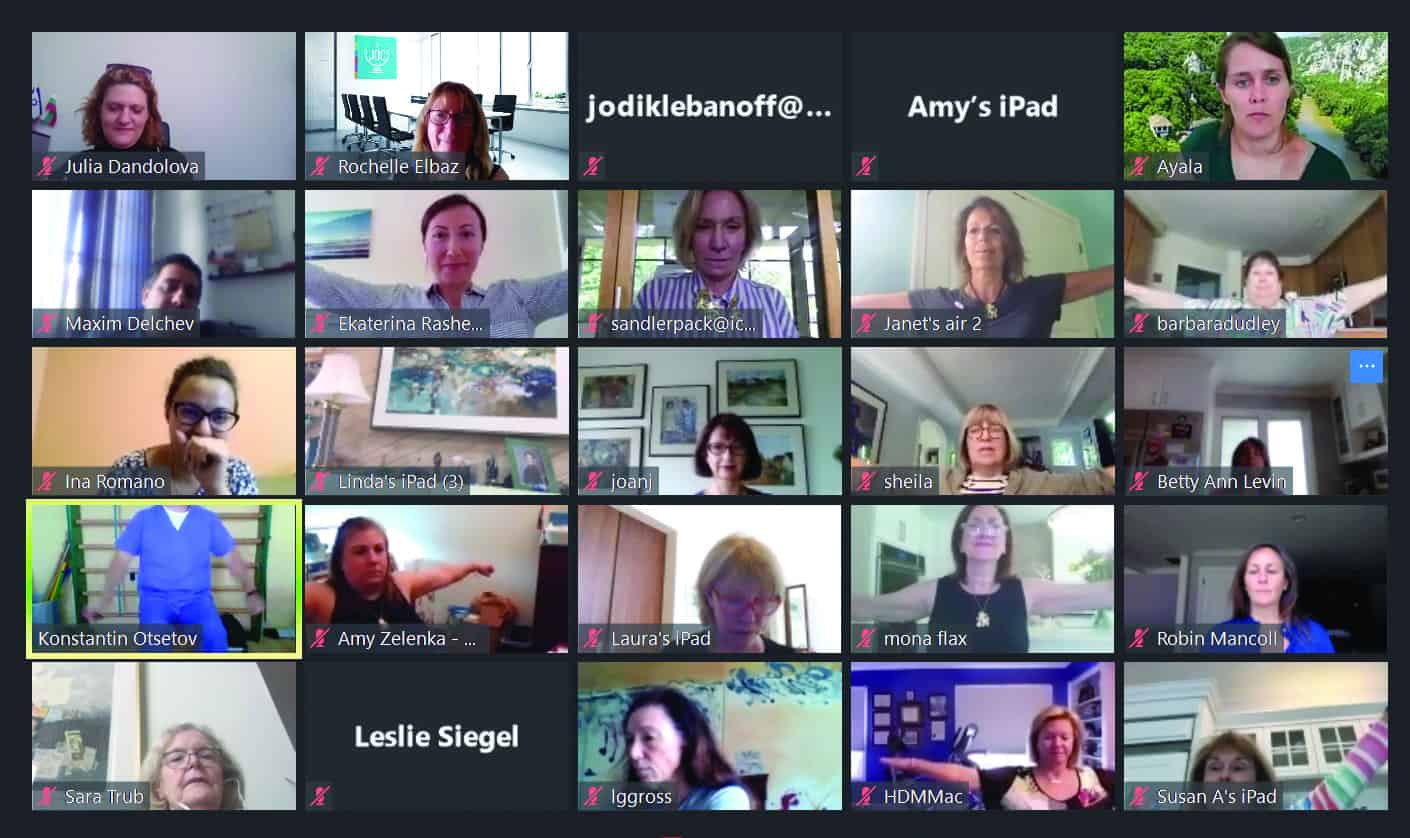 Over three dozen local Jewish women, led by mission co-chairs Annie Sandler and Mona Flax, along with JDC professional Sandy Katz, made the long trek to the Jewish communities of Minsk in Belarus and Sofia in Bulgaria…all through the “magic” of the internet.
Over three dozen local Jewish women, led by mission co-chairs Annie Sandler and Mona Flax, along with JDC professional Sandy Katz, made the long trek to the Jewish communities of Minsk in Belarus and Sofia in Bulgaria…all through the “magic” of the internet.
Following their donor dollars, these women boarded a virtual plane to explore a variety of programs and services being provided by Tidewater’s overseas service delivery partner, the American Jewish Joint Distribution Committee.
The three-part mission took place over the course of a week in 90-minute sessions, featuring the work of JDC professionals and the community members who receive life altering services funded, in part, by the dollars raised through the Federation’s community campaign each year.
As has been the case here in Tidewater, the Jewish communities in Minsk and Sofia have had to change the way they serve their communities, as a result of the COVID-19 pandemic and the resulting need for social distancing and relative isolation.
Nowhere was this more evident than in the elder populations of both countries. For a group which tends toward social isolation even in good times, COVID-19 has brought their circumstances to a new level, which had the potential to be devastating, if not for the work of JDC professionals and the volunteer programs they manage.
While waiting in the ‘airport lounge,’ Mona Flax introduced the group to JDC’s CEO, Asher Ostrin, who gave a brief history of the JDC and the variety of work it does in Jewish communities of every size, all over the world. He shared inspiring, personal stories, and thanked the participants for their role in supporting both the Jewish community of Tidewater, and the global Jewish community.
After ‘landing’ in Minsk on day one of the mission, the group received an overview of the Jewish community of Belarus, whose history is believed to date back to the 8th Century. The community has faced monumental challenges over the course of time (including expulsions; pogroms; the Holocaust, which saw the murder of nearly two-thirds of the Jewish population; and Communism, which sought to completely erase Jewish history, culture, and practices).
The group proceeded to its first ‘home visit.’ JDC client, Ludmila Starikovich is an elderly woman who suffers from a musculoskeletal system disease, diabetes, and obesity. She lives just a 10-minute walk from the local supermarket, but she hasn’t been there in years. A fall left her homebound, and more recently she lost her vision. Ludmila shares a run-down apartment with her often-unemployed adult son. Her monthly pension is $162, from which she pays $95 for utilities and land tax each month; not leaving much for food, medicine, and other necessities. Through its Hesed program, JDC provides Ludmila with 12 hours per week of home care, delivery of hot lunches, and personal hygiene items she desperately needs. JDC is Ludmila’s lifeline. She describes her JDC homecare worker as “the sunshine in my window.” She spoke to the group about her background, her struggles, and also her gratitude for the services she receives from JDC. “You support me, feed me, and take care of me.” She tearfully thanked the mission participants for supporting JDC and her. She was overwhelmed to know that there are Jews living thousands of miles from Belarus who care about her, worry about her, and give money to make sure that she and others can live, if not without difficulty, then at least with dignity.
Ludmila was just one of the people we met during the mission, who thanked us for acting to ensure their well-being.
The group then participated in an interactive program designed to help strengthen and preserve memory among the elderly—particularly those who are showing signs of forgetfulness. A series of carefully constructed puzzles and activities asked to look for and memorize patterns, to read aloud a series of numbers which was printed in various colors, then to read aloud the colors of the printed numbers. It quickly became obvious how these activities keep participants focused and attentive, things which have become increasingly important during the COVID-19 crises, as so many elderly are socially distanced, isolated, and alone with their thoughts.
Day two of the mission started in Belarus, but this time with the Active Teens group. This group of Jewish teenagers come together to celebrate their Jewish identity, engage in Jewish rituals, and volunteer their services in the Jewish community. We met four wonderful young ladies who shared their backgrounds with us, their favorite part of being an Active Jewish Teen, as well as their aspirations for the future. In break-out sessions, we got to know the girls a little better, as well as one another (in true mission fashion!). Many talked about their love of Kabalat Shabbat, making our entire group want to join them for such an event, very soon!
The girls then led us in a (COVID-19 appropriate) mask-making exercise. Each participant had received a package with all of the materials required to make a mask, prior to the mission. And so, we began together what would become a homework assignment, with participants completing their masks that evening.
As we bid farewell and Dasvidaniya to our friends in Minsk, we looked forward to meeting new ones in the Jewish community of Sofia, Bulgaria. Once again, through the magic of Zoom, our group ‘boarded a plane’ in Minsk for the less-than-10-second flight (and 1,163 miles away) to Sofia. We were met on arrival by a young tour guide, Slavyan Kanovsky (who had visited Tidewater a few years ago as a young leader in the Sofia Jewish community). After a two-minute whirlwind tour through the beautiful scenery of historic Sofia, we learned about the country’s Jewish history.
Jews have had a continuous presence in historic Bulgarian lands since before the 2nd century. That was surprising. But astonishing was learning how the church and the king and members of the country’s literati protected the Jews of Bulgaria, during the Holocaust—stalling, delaying, and ultimately refusing to deport them. So while their lives through the war were difficult (with property confiscated, expulsion to the provinces—many sent to forced labor camps), they did, in fact, live. Unlike its closest neighbors, Macedonia and Greece (whose Jewish populations were essentially wiped out during the Holocaust), the Jewish population of Bulgaria came through the war largely intact. It was after the war that a mass migration took place. Today, the majority of Bulgarian Jews live in Israel (about 44,000), while about 1,000 live in Bulgaria.
Kanovsky left the group at Beit Shalom, Bulgaria’s JCC, where we were welcomed by the Center’s CEO. Growing up in Communist Bulgaria, the word “Jewish” did not mean much to Julia Dandolova. But when the Iron Curtain fell, she slowly began to embrace her Jewish identity, first attending and then staffing JDC’s Jewish camps, clubs, and counselor trainings. Soon, Dandolova was JDC’s country director in Bulgaria. Over time, as JDC transitioned its programs to the community, the Beit Shalom JCC was established and Julia became its CEO. Dandolova spoke about the Bulgarian Jewish community and about its people, noting that they “are not much for smiling,” but assuring that this doesn’t mean they’re unhappy. Day two of the mission ended Dandolova’s welcome and a briefing about the various kinds of programs and services offered to the community through the Shalom Center.
Day three of the mission was bittersweet. The group looked forward to learning more about Jewish life in Bulgaria, but no one wanted the trip to end. In advance of our meeting, several of the community’s “grandmothers”…collected and compiled “grandmother stories” from the mission participants, and each participant received a hand-woven red and white Martenitsa bracelet. The giving and wearing of a Martenitsa is a uniquely Bulgarian tradition, celebrating Baba Marta (or Grandma March) and the welcoming of spring. So while our seasons may have been a bit “off,” it was a great pleasure getting to know our fellow travelers through stories about grandmothers and grandmother-figures.
The day began with an overview of Bulgaria’s Jewish welfare offerings. Longevity, we learned, was a characteristic of this community, which boasts dozens of active 80- and 90-year-old members, and even a fair number of 100+ year-olds. We learned that part of the “secret sauce” which keeps the community’s seniors in good health is the high priority they place on physical activity. And so, the mission participants took part in an exercise regimen designed to keep those seniors active while sheltering at home. Working our arms and legs, we experienced some of the exercises specially designed by the JCC’s fitness instructor for the Jewish seniors in Bulgaria. It was a lot of fun and not a bad habit to get into!
Following our work-out, the group met with the community’s leaders and broke out into small work groups (to report back later). Much of the discussion centered on the community’s pre-school and day school programming. A new day school, donated by American philanthropist Ronald Lauder, has become a shining jewel in the Jewish community of Sofia. Jewish preschool is in such high demand that there is a waiting list for enrollment. Moving up the age chain, Bulgaria’s Jewish teens are finding great joy and fulfillment in their involvement with local volunteer groups, as well as with BBYO. Who knows? Perhaps some of our teens have met some of the Bulgarian teens at International Convention or ILTC.
In talking with these community leaders (many of them young and the products of leadership programs we help to fund) it was extremely gratifying to know that not only are our campaign dollars funding programs and services for individuals and families around the Jewish world…but perhaps more importantly, they are funding the future of these Jewish communities through investment in their children, teens, and young adults. These young people come back to their communities from Limmud programs across Europe; from Sarvas and other Jewish summer camps across the region; and even from BBYO International Convention in the United States with fresh eyes, fresh ideas, new ways of tackling challenges, and boundless energy.
These once at-risk communities—communities dealt the harshest of blows from the Holocaust to the Communist era—seem well-positioned to blossom in the coming years, as their young leaders take the reins with joy and with pride in their Jewish culture and history. And it was a beautiful thing to experience.
The mission closed with mission co-chairs Annie Sandler and Mona Flax thanking all for participating, as well as the JDC and Federation professionals who helped plan the ‘trip.’ They introduced our final speaker, Dr. William Recant, JDC’s assistant executive vice president. In summing up our mission experience, Recant had especially warm words for Tidewater and its unflagging support for the work of JDC in Eastern Europe and the Former Soviet Union, in Israel, Cuba, Argentina, and everywhere else a Jew is in need, and JDC is there to help. In his always eloquent way, Recant asked the women to keep up the good work and to continue encouraging others to join. Sounds just like what we do!
– Amy Zelenka

